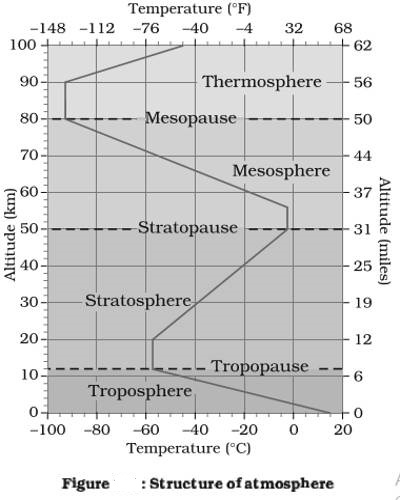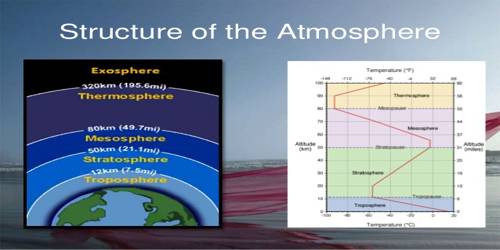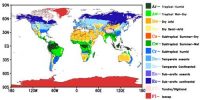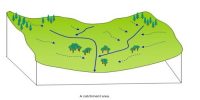Structure of the Atmosphere
The atmosphere consists of different layers with varying density and temperature. Density is highest near the surface of the earth and decreases with increasing altitude. The column of atmosphere is divided into five different layers depending upon the temperature condition. They are- troposphere, stratosphere, mesosphere, ionosphere, and exosphere.
The troposphere is the lowermost layer of the atmosphere. Its average height is 13 km and extends roughly to a height of 8 km near the poles and about 18 km at the equator. The thickness of the troposphere is greatest at the equator because heat is transported to great heights by strong convectional currents. This layer contains dust particles and water vapor. All changes in climate and weather take place in this layer. The temperature in this layer decreases at the rate of 1°C for every 165m of height. This is the most important layer of all biological activity.
The zone separating the troposphere from the stratosphere is known as the tropopause. The air temperature at the tropopause is about minus 80°C over the equator and about minus 45°C over the poles. The temperature here is nearly constant, and hence, it is called the tropopause. The stratosphere is found above the tropopause and extends up to a height of 50 km. One important feature of the stratosphere is that it contains the ozone layer. This layer absorbs ultra-violet radiation and shields life on the earth from intense, harmful form of energy.

The mesosphere lies above the stratosphere, which extends up to a height of 80 km. In this layer, once again, the temperature starts decreasing with the increase in altitude and reaches up to minus 100°C at the height of 80 km. The upper limit of the mesosphere is known as the mesopause. The ionosphere is located between 80 and 400 km above the mesopause. It contains electrically charged particles known as ions, and hence, it is known as the ionosphere. Radio waves transmitted from the earth are reflected back to the earth by this layer. The temperature here starts increasing with height. The uppermost layer of the atmosphere above the ionosphere is known as the exosphere. This is the highest layer but very little is known about it. Whatever contents are there, these are extremely rarefied in this layer, and it gradually merges with the outer space. Although all layers of the atmosphere must be exercising influence on us, geographers are concerned with the first two layers of the atmosphere.
















